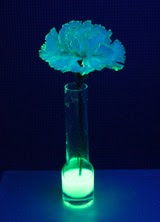Vegetables and colour
Vegetables and colour
The pigment present in carrots is the
betacarotene, with 9 linear conjugated double bonds, less than in
lycopene so they are no red but orange (smaller wavelength than red, check it in
the spectrum picture). This compound is also a potent antioxidant and besides
it's transformed in our body into vitamin A, very important for the maintenance
of healthy skin, good vision and a robust inmune
system.
Spinachs, parsley and plants in general are green because they contain chlorophyll, a pigment which enables the plant to carry on photosynthesis, transforming solar energy and carbon dioxide into chemical energy in the form of carbohydrates and oxygen. This is a process essential for life.
As you can see in the pic below, the structure of chlorophyll is very complicated, so let's simpy say that it contains a big ring with a magnesium atom in the center. Curiously, the structure of hemoglobine (the carrier of oxygen in our blood) is pretty similar to chlorophyll, though it has an atom of iron instead of magnesium in its center.
The chlorophyll masks the other colours in vegetables and as its amount decreases the rest of colours become evident. This explains for example why tomatoes are initially green and then become red when they ripen.
This is an example of how Chemistry is everywhere, sometimes more evident, and sometimes much less :-).
Spinachs, parsley and plants in general are green because they contain chlorophyll, a pigment which enables the plant to carry on photosynthesis, transforming solar energy and carbon dioxide into chemical energy in the form of carbohydrates and oxygen. This is a process essential for life.
As you can see in the pic below, the structure of chlorophyll is very complicated, so let's simpy say that it contains a big ring with a magnesium atom in the center. Curiously, the structure of hemoglobine (the carrier of oxygen in our blood) is pretty similar to chlorophyll, though it has an atom of iron instead of magnesium in its center.
The chlorophyll masks the other colours in vegetables and as its amount decreases the rest of colours become evident. This explains for example why tomatoes are initially green and then become red when they ripen.
This is an example of how Chemistry is everywhere, sometimes more evident, and sometimes much less :-).


Comments
Post a Comment